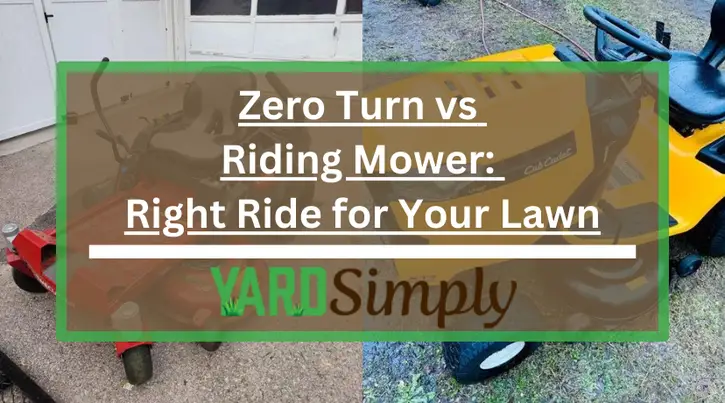As a seasoned landscaper with over a decade of experience, I’ve navigated the complexities of lawn maintenance, particularly in the choice between zero-turn and riding mowers.
This article leverages my extensive hands-on experience and deep understanding of these machines, providing you with clear, concise insights.
Whether you’re a homeowner or a professional, you can rely on my expertise to guide you in making an informed decision in the zero-turn vs riding mower debate. Let’s delve into the specifics, helping you choose the right mower for your lawn’s needs.
Comparison: Zero Turn Mowers vs. Riding Mowers
When deciding between a zero turn and a riding mower, it’s crucial to understand how their steering mechanisms and maneuverability differ significantly.
Zero turn mowers boast superior maneuverability, thanks to their independent wheel motors which allow them to pivot on a dime. This makes them the go-to choice for lawns with intricate landscaping or numerous obstacles.
In contrast, riding mowers have a traditional steering wheel, and while they can’t match the zero turn’s agility, they’re still pretty handy for large, open spaces.
Speed efficiency ties into maneuverability. I’ve found that zero turn mowers usually work faster, cutting down mowing time considerably, especially on complex lawns.
Considering lawn size is important too; riding mowers may be more economical for vast, flat areas, despite being slower.
Terrain considerations are key. My zero turn struggles on steep slopes, where a riding mower’s lower center of gravity offers better stability.
Also, maintenance costs can’t be overlooked. Typically, I spend more on upkeep for my zero turn due to its complex parts, whereas my riding mower is generally less expensive to maintain.
Understanding Zero Turn Mowers
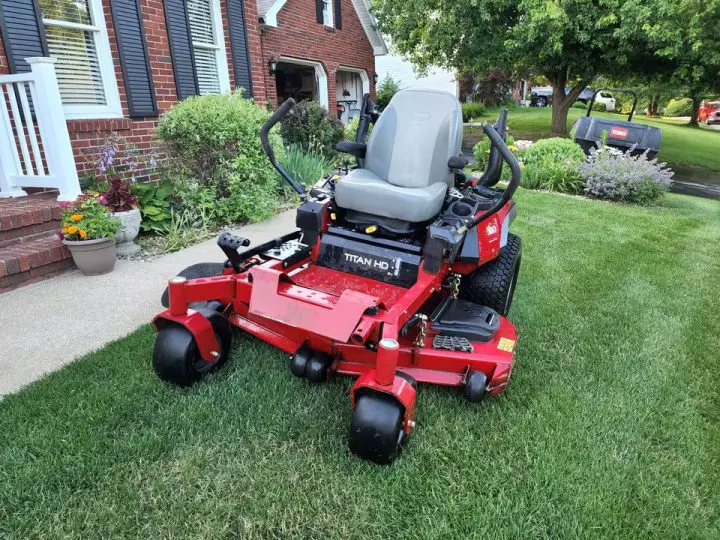
Let’s get to grips with zero turn mowers and what sets them apart.
I’ll examine their advantages and potential drawbacks, ensuring you’ve got a clear picture.
Then, I’ll contrast them with traditional riding mowers to help you make an informed choice.
Benefits and Drawbacks of Zero Turn Mowers
Let’s take a closer look at what sets zero turn mowers apart from their riding counterparts.
I’ll explore the key benefits that make them a popular choice for many, but I won’t ignore the drawbacks that might sway your decision.
Key Advantages of Using Zero Turn Mowers
Zero turn mowers offer unparalleled maneuverability, allowing for precise cuts and efficient navigation around obstacles in the lawn.
Their maneuverability mastery is a game-changer, sharply reducing the time it takes to mow. I’ve noticed a significant efficiency increase compared to traditional riding mowers.
The landscape impact is minimal with their gentle touch. Plus, maintenance ease is a key perk.
In a speed comparison, zero turns consistently come out on top.
Notable Disadvantages of Zero Turn Mowers
While zero turn mowers excel in many areas, they also come with several drawbacks worth considering.
The cost comparison can be startling; they’re often pricier than traditional riding mowers.
Zero turn limitations become apparent on slopes, where they struggle with traction differences.
Not to mention, their maintenance complexity can be daunting for some.
It’s clear that these mowers aren’t perfect for every situation.
Related Articles:
- Husqvarna Zero Turn Mower Problems
- Cub Cadet Zero Turn Mower Problems
- Gravely Zero Turn Mower Problems
Exploring Riding Mowers
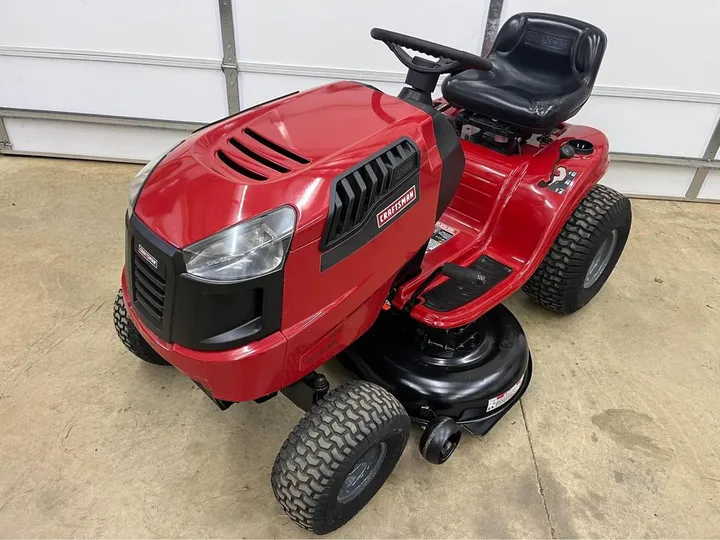
Now, I’ll turn my attention to traditional riding mowers, which offer a different set of pros and cons compared to their zero turn counterparts.
While they may not be as nimble, riding mowers have their own advantages that might make them a better choice for some users.
Let’s examine what sets these machines apart, taking into account the unique benefits and potential drawbacks they bring to lawn maintenance.
Advantages and Disadvantages of Riding Mowers
Riding mowers, often favored for their comfort and stability, come with a unique set of advantages and disadvantages compared to their zero turn counterparts.
They’re better for large lawns where mower maintenance, terrain adaptability, and fuel efficiency matter.
However, they’re less nimble and may struggle with uneven ground. Plus, grass disposal options can be more limited, making them less versatile in some scenarios.
Evaluating the Purchase of a Zero Turn Mower
Before investing in a zero turn mower, it’s crucial to assess its advantages in efficiency and maneuverability against the cost and learning curve involved.
I’ve learned that mower maintenance tips are vital for longevity, and zero turn mowers require consistent upkeep. Considering my lawn size is also key; these mowers excel on large, open spaces but may not be the best choice for smaller yards.
Terrain adaptability is another significant factor. My property has some hilly spots, and I’ve found that zero turn mowers can be tricky on slopes, which weighs into the decision. Budget considerations are, of course, front and center.
Zero turn models can be pricier upfront, but I’ve to weigh that against the potential time savings. Am I willing to invest more now for efficiency later?
Lastly, I think about seasonal usage patterns. My lawn needs more frequent cuts during the spring and less in the fall.
A zero turn mower might save me hours during peak seasons, but is it worth the cost if it’s just sitting in the garage for half the year? It’s a tough call, but considering all these aspects helps me make an informed decision.
Zero Turn Mowers I Will Choose
When it comes to selecting a zero turn mower, I’ve narrowed down my options to a few standout models.
I’m considering the Toro TimeCutter SS4225 for its user-friendly features, the Husqvarna Z254F for its durability, and the Ariens IKON-X 52 for its cutting performance.
Each of these mowers has unique advantages that I’ll need to weigh before making my final decision.
Toro TimeCutter SS4225
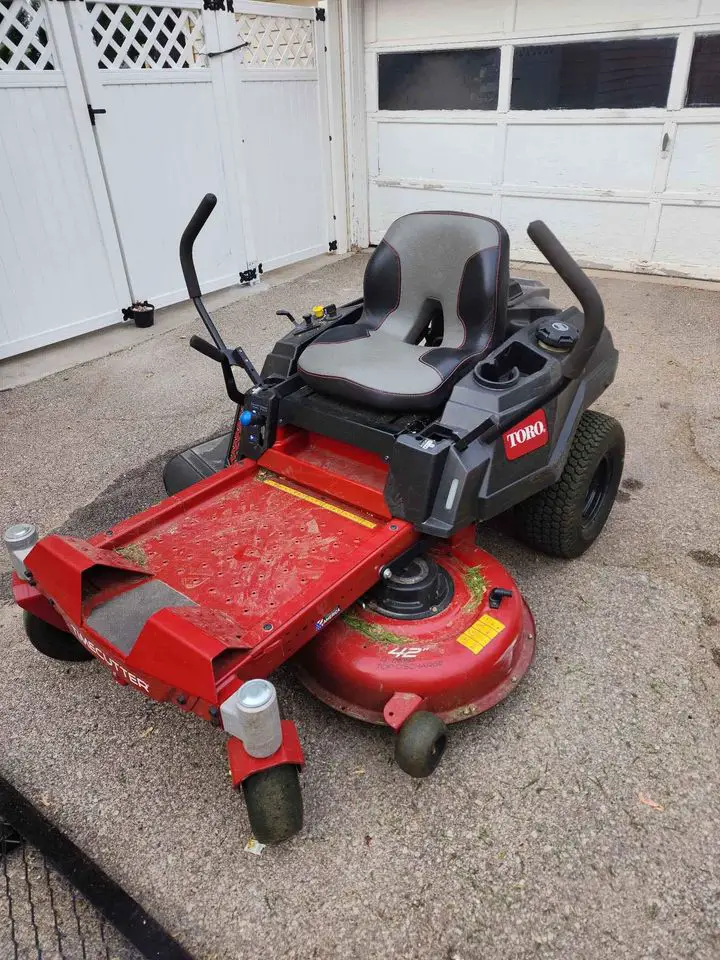
The Toro TimeCutter SS4225 stands out as a robust zero-turn mower designed for efficiency and comfort. I’m impressed by its Toro durability, which means less worry about frequent repairs.
I’ve learned some maintenance tips too, such as keeping the air filter clean and blades sharp, which ensure it runs like a charm. Its fuel efficiency is a real money-saver, and I don’t have to refill as often as I thought I would.
The cutting precision is second to none, making my lawn look professionally manicured with every pass. Plus, the accessorizing options are fantastic; whether I need a bagger or a sunshade, I can customize my TimeCutter to fit my needs perfectly.
It’s a smart choice for any homeowner looking for a reliable mower.
Husqvarna Z254F
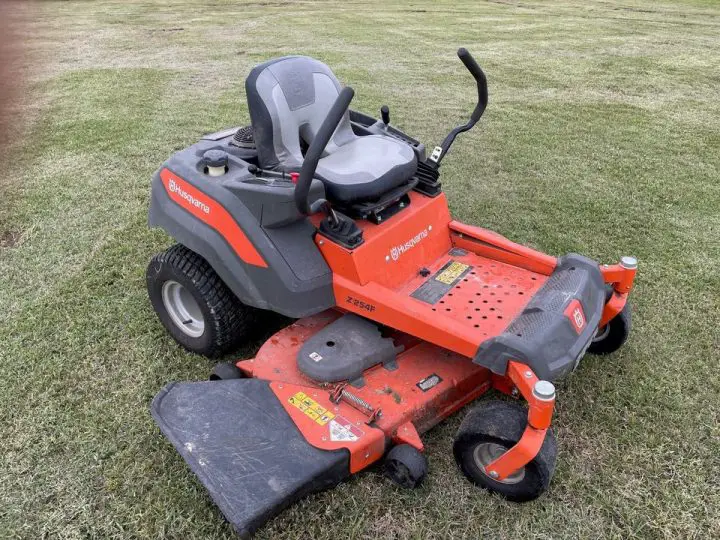
While the Toro TimeCutter SS4225 is a prime example of zero-turn efficiency, Husqvarna’s Z254F model elevates the mowing experience with features that cater to both speed and durability.
I’ve noticed Husqvarna durability firsthand—the Z254F’s robust frame and cutting deck are built to last, handling rough terrain without a hitch. Its 54-inch deck size allows me to cover more ground quicker, boosting my cutting speed significantly.
Moreover, I appreciate the fuel efficiency of this mower; it means fewer stops to refuel and more continuous mowing. As for maintenance tips, I keep the blades sharp and the deck clean, ensuring it runs smoothly every time.
With these practices, I’ve found the Z254F to be a reliable partner in lawn care.
Related: Husqvarna Z254F Review
Ariens IKON-X 52
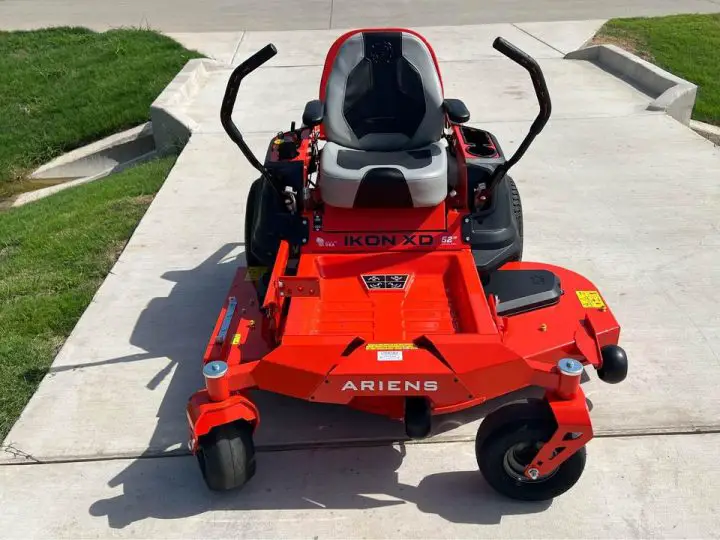
Shifting gears to the Ariens IKON-X 52, I’ve found its precision cutting and comfort design to be unparalleled in the realm of zero turn mowers. The Ariens durability shines through with every use.
It feels like this mower was engineered to last, and the robust frame suggests it can handle almost any challenge I throw at it.
The comfort features are top-notch too; the high-back seat and armrests make mowing my lawn less of a chore and more of a pleasure.
Furthermore, the fuel efficiency is impressive. I’m spending less on gas and getting more lawn covered. The 52-inch deck size is perfect for my property, making quick work of expansive areas.
And the warranty options provide peace of mind, knowing that I’m covered if anything goes awry.
Learn More: Ariens Zero Turn Mower Reviews
Riding Mowers I Will Choose
When it comes to selecting a riding mower, I’ve narrowed down my options to a few standout models.
The John Deere S100 appeals to me for its durability and brand reputation.
The Cub Cadet XT1 Enduro LT 42 in catches my eye with its cutting-edge features.
Lastly, the Craftsman T225 is on my radar for its balance of performance and affordability.
John Deere S100
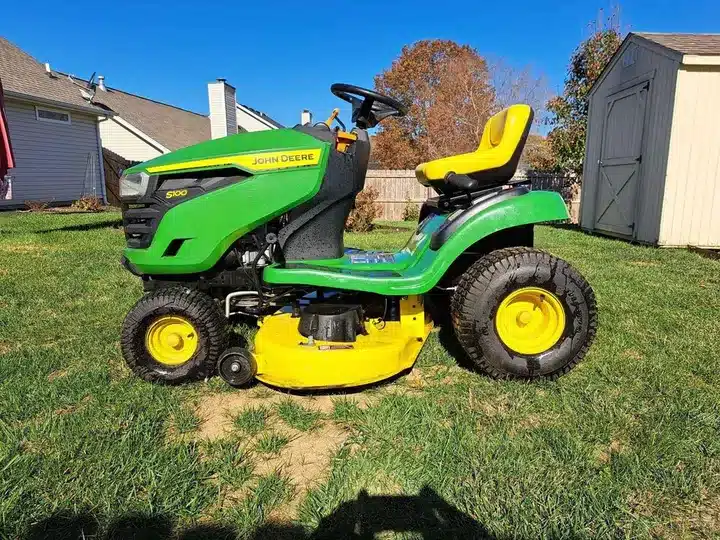
In the realm of riding mowers, the John Deere S100 stands out for its balance of performance and affordability. I’ve come to appreciate the John Deere heritage; it’s a brand that’s synonymous with durability and quality.
When I consider my lawn size, which is substantial but not sprawling, the S100 seems like a wise choice. Its terrain adaptability is impressive, handling both flat surfaces and gentle slopes with ease.
I’m particularly mindful of maintenance requirements, and the S100 doesn’t disappoint. It’s designed for straightforward upkeep, which means I can handle most of the routine tasks myself. Plus, its fuel efficiency is a boon for my wallet.
It’s a mower that meets my needs without overcomplicating things — a perfect blend of simplicity and capability.
Read More: John Deere Zero Turn Mower Reviews
Cub Cadet XT1 Enduro LT 42 in
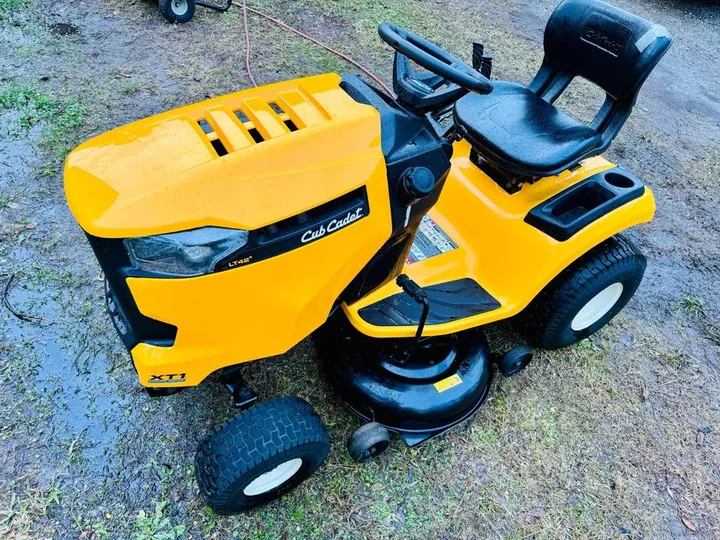
The Cub Cadet XT1 Enduro LT 42 in. riding mower commands attention with its robust construction and precision cutting capabilities, ideal for homeowners seeking a reliable and efficient lawn care solution.
I’m particularly impressed with the Cub Cadet reliability, which is crucial when I’m tackling my residential lawn suitability needs.
The Enduro Series features, including the optimized steering system and comfortable seating, make my mowing tasks less of a chore and more of a pleasure.
When it comes to LT 42 maintenance, it’s straightforward, ensuring that I can keep the machine in top condition with minimal fuss. It’s also a champ in garden landscaping compatibility, easily maneuvering around flower beds and tree lines.
This rider is a powerhouse for keeping my yard looking its best.
Craftsman T225
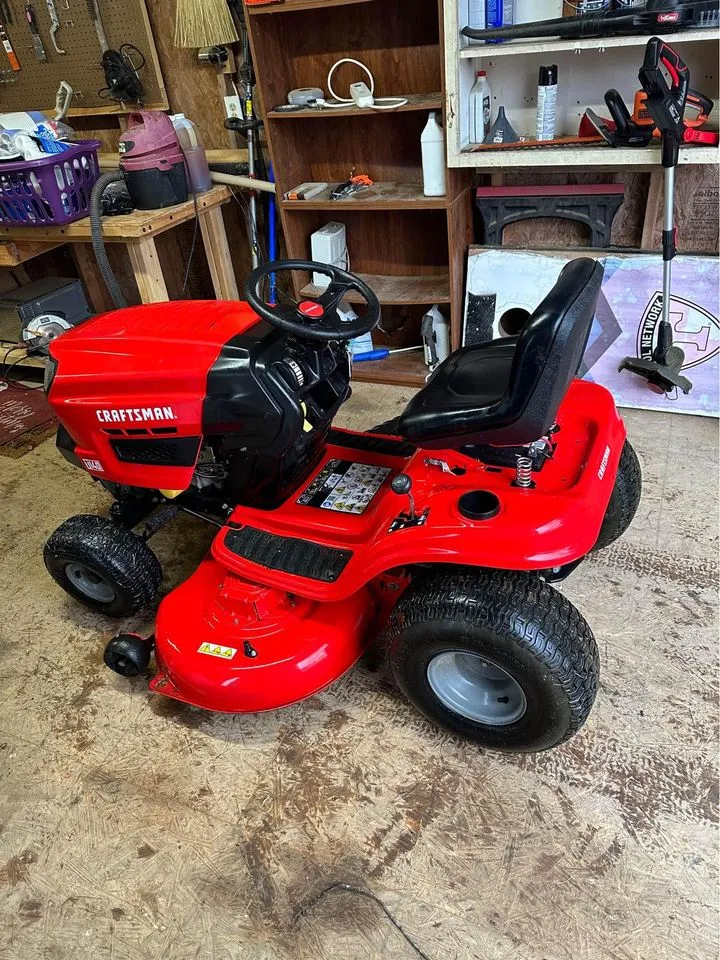
Boasting a powerful 19 HP Briggs & Stratton engine, the Craftsman T225 riding mower stands out as my go-to machine for its exceptional durability and performance on medium-sized lawns.
I’ve come to rely on Craftsman reliability, knowing this mower can handle varied terrain with ease. Its broad 46-inch cutting deck saves me time, and the mower’s design ensures a clean, even cut across my lawn’s diverse landscape.
To keep it running smoothly, I follow a few maintenance tips like regular oil changes and blade sharpening. I’ve also explored various accessory options, adding a mulch kit to nourish my lawn as I mow.
Whether I’m navigating gentle slopes or maneuvering around obstacles, the T225 consistently meets the demands of my lawn care routine.
Our Verdict
The zero turn vs riding mower debate, I’m leaning towards the zero turn mower for my needs. Its unparalleled maneuverability and speed have consistently impressed me in navigating my complex landscape.
The way it eases around obstacles and trims down mowing time is a game-changer. Of course, I do see the value in riding mowers for simpler, more expansive lawns. They’re a great budget-friendly option.
But, given the unique demands of my garden, with its nooks and crannies, the zero-turn mower is my top pick. It’s all about finding that perfect match for your lawn’s individual character, and for mine, the zero-turn mower is just that!
Frequently Asked Questions
Can zero turn mowers safely operate on slopes, and if so, what is the maximum recommended incline?
I’ve learned that mowers can handle slopes, but steep inclines pose traction issues. Following manufacturer guidelines, considering weight distribution, and relying on operator experience are key for safe operation on maximum recommended inclines.
How do zero turn mowers handle varying lawn conditions, such as wet grass or uneven terrain, compared to riding mowers?
I’ve noticed that my mower’s stability and traction control handle wet grass well, but uneven terrain can be tricky. The weight distribution affects grass discharge and cutting patterns, requiring careful maneuvering.
Are there any attachments or accessories that can be added to zero turn or riding mowers to enhance their functionality beyond lawn cutting?
I’ve seen mulching kits, snow plows, trailer hitches, dethatching attachments, and grass catchers that can be added to enhance mowers’ functionality. They’re great for turning a simple mower into a multi-purpose tool.
What are the typical maintenance requirements and intervals for zero turn mowers compared to riding mowers?
I regularly perform engine maintenance, oil changes, blade sharpening, air filter replacements, and tire pressure checks to keep my mower running smoothly. These tasks are essential for optimal performance and longevity.
How do the lifespans of zero turn mowers compare to those of traditional riding mowers under similar usage conditions?
I’ve found that mower durability often hinges on usage frequency, engine types, and brand comparisons. Warranties also differ, which can be a big factor in a mower’s lifespan under similar conditions.
Conclusion
In wrapping up, I’ve to say, after weighing the pros and cons, my heart is set on the zero-turn mower for its impressive maneuverability and speed. I’ve seen firsthand how it can transform mowing a complex landscape from a chore into a breeze.
Nevertheless, I acknowledge that riding mowers hold their ground as a budget-friendly option for simpler lawns. If my yard were less demanding, I’d lean towards a riding mower without hesitation. But for my sprawling, obstacle-laden green space, the zero-turn is a clear winner.
It’s all about matching the machine to your garden’s personality.

